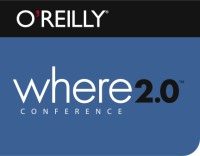 I’ve attended a few sessions so far at Where 2.0 today, with more to come. I’ll keep this posted updated throughout the day.
I’ve attended a few sessions so far at Where 2.0 today, with more to come. I’ll keep this posted updated throughout the day.
While most of the information today is focused more on location-based services like Foursquare, there is certainly some interesting stuff being shared.
The first session was “Mining the Geo Needles in the Social Haystack” by Matthew Russell
He showed off some interesting tools, such as the ability to turn a list of locations (like this one) through the tool at microform.at to generate a KML file like this one![]() . Very slick.
. Very slick.
He then covered ways to use mine geo data from various services such as Twitter, LinkedIn and Facebook. As an example, you can see how oAuth works with Facebook on this sample page.
Finally, he showed some ways to extract location data from natural language for cases where geo-coded data isn’t available. Considering this is the vast majority of data out there (text on websites, text messages, etc), it’s a valuable tool to develop. For some tools that work on that, check out www.datasciencetoolkit.org.
Next I checked out “Why Data Collection Must Extend Beyond the Check-in“, presented by Scott Hotes and Mohit Gupta from Location Labs.
They worked on showing a detailed breakdown of what “check-in” really is, covered the growing issue of fragmented place databases and how they all differ, and some ways to track phones (with consent) in various scenarios such as check-ins, parent/child tracking, etc.
Next was “Hands on Map Scripting” by Adam DuVander (@adamd) of ProgrammableWeb.
He spoke a bit about the new changes we’ve seen over the last few years in regards to mapping APIs (more mobile, etc), but spent most of the time walking us through Mapstraction. Mapstraction is a very cool way to write code for a single map that will work acorss a variety of mapping APIs (Google, Bing, etc). If you write any mapping code for a site, it’s something you need to check out.
Next was “Getting Started with Google Maps and Fusion Tables” by Kathryn Hurley and Mano Marks. After Mano gave us an overview of Fusion Tables, then Kathryn walked us through creating a basic Fusion Table ourselves. Even better, they’ve provided the full tutorial if you’d like to walk through it yourself! There’s quite a lot of power in this feature, and the tutorial is a great way to get started.
Later this evening I’ll check out the various “Ignite” sessions, where many groups will be quickly showing off their ideas.